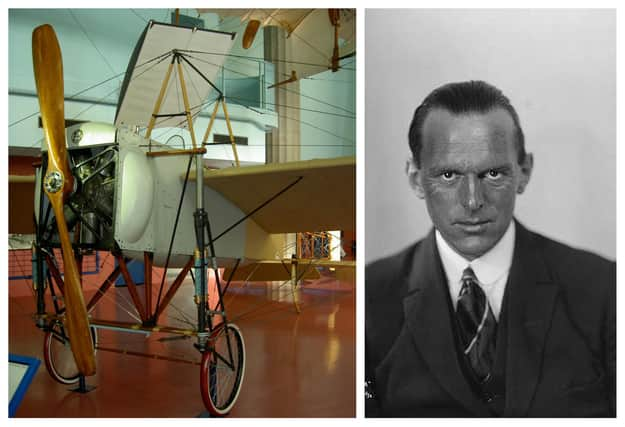The first terrifying flight across the North Sea celebrated in both Scotland and Norway


The 1914 flight by Tryggve Gran, an adventurer who was on Captain Robert Falcon Scott’s doomed Polar expedition two years earlier, is now remembered in both Cruden Bay and the field south of Stavangar in Norway where he ended his terrifying journey.
Aged just 26, he crated up his Bleriot monoplane and put it on a train that arrived at Aberdeen station that July. From there, he headed north, sure that the shortest journey across the North Sea had to start in Buchan.
Advertisement
Hide AdAdvertisement
Hide AdGordon Casely,a North East journalist who became fascinated by the Gran story, visited the adventurer many years later at his remote home some 200 miles from Oslo to hear about the mission to secure a world first.
Gran told the reporter: "I don't remember much of Aberdeen or the countryside we travelled through. I was much too busy worrying for my crated aeroplane on the back of a (steam) lorry. But I do remember the young boys who crowded round at every stop".
That very monoplane is now held in Norway’s national collection.
From his headquarters at Cruden Bay Hotel, Gran searched “increasingly desperately” for a basic take-off point, he told Casely.
Finally, he selected a sloping strip of grass between the main road and the hotel. He had one chance to get it right given at the end of the makeshift runway stretched the electric wires that ran the trams from the hotel to Cruden Bay station.
Sandy Cruickshank, of Port Erroll near Peterhead, then a young caddy on the golf course that morning, witnessed Gran’s first attempt at take off. He remembered his ‘mounting anxiety’ as he watched the pilot lumbering down the hill with his monoplone, its wheels looking more like they belonged on a pram than on an aircraft.
Gran recalled the moment he took off: "I had every drop of fuel aboard that I could carry, and I had forgotten about the tram wire until too late. I asked the good Lord to help me, and we cleared the wire".
The pilot flew for 70 minutes across the sea until fog turned him back. He landed on the only flat area he could see – the sands – with Gran stopping the plane by steering it into the sea given it had no brakes. A couple of horses were used to pull the aircraft of the water.
Advertisement
Hide AdAdvertisement
Hide AdHe took off from the beach for his second attempt just after 1 p.m, with just an aneroid, clock, compass and a ‘keen sense of direction’ for guidance. He wore just a shirt, thin jersey and flying jacket so that if his plane came, he could swim for it.
For 70 miles, the journey went well but a petrol pump which was accidentally left running caused a fuel cut-out and the engine to stall.
He couldn't restart the engine on a second tank until he dropped to 15 feet above the sea. "There were some very critical seconds,” he told Casely.
The down-draft started the propellers going again, and he flattened out thirty metres above the water. For a second time, he ‘prayed to the good Lord to help me’ with him soon heading back up towards the clouds.
Gran landed in a field on a farm near Stavanger, four hours and ten minutes after leaving Scotland, with a third prayer said on approach.
Gran left his engine running and then ran from his craft, leaving an onlooking farmer – who had never seen a plane before – absolutely stunned.
Mike Shepherd, of the Port Erroll Heritage Group, said: “When Tryggve Gran got to Norway, he was faced with some pretty wild terrain. He spotted a field around 50 to 60 miles south of Stavanger and landed there. The farmer was astonished as he had never seen a plane before. Tryggve had to go off and find a post office to send a telegram as the Daily Mail had a prize waiting for him if he made the crossing.
"When he came back, the farmer had taken a rope and tethered it to a boulder because he thought it might take off again.”
Advertisement
Hide AdAdvertisement
Hide AdIn 1912, Tryggve Gran was appointed as a skiing expert to the British Antarctic Expedition by Captain Scott, who died alongside all members of the British party on their return from the South Pole, with their bodies and journals found by a search party some eigh months later. Gran was part of that search party and indeed found Scott’s body.
Mr Shepherd said: “After finding Scott’s body, Gran took his skiis and made a cross for him. He took Scott’s skiis to skii back so there was something of Scott’s that made the return journey.”
New display boards which celebrate the flight have been installed in Cruden Bay and the field in Jaeren in Norway, where Gran landed.
The board at Cruden Bay has been funded by NorthConnect, a joint venture company who aim to build a power connection between Scotland and Norway.
A message from the Editor:Thank you for reading this story on our website. While I have your attention, I also have an important request to make of you.With the coronavirus lockdown having a major impact on many of our advertisers - and consequently the revenue we receive - we are more reliant than ever on you taking out a digital subscription.Subscribe to scotsman.com and enjoy unlimited access to Scottish news and information online and on our app. With a digital subscription, you can read more than 5 articles, see fewer ads, enjoy faster load times, and get access to exclusive newsletters and content. Visit https://www.scotsman.com/subscriptions now to sign up.